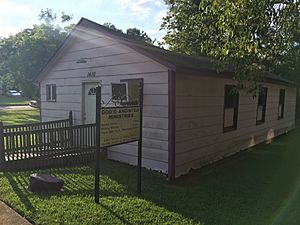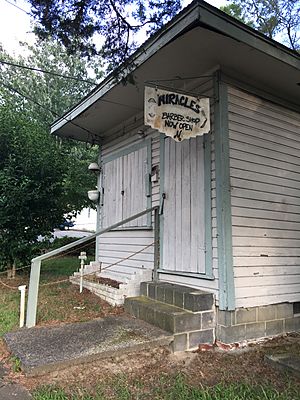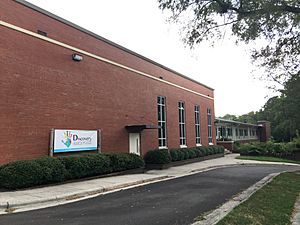Walltown, Durham, North Carolina facts for kids
Quick facts for kids
Walltown
|
|
|---|---|
|
Durham neighborhood
|
|

Houses on Berkeley Street in Walltown.
|
|
| Country | United States |
| State | North Carolina |
| City | Durham |
| Named for | George Wall |
| Time zone | EST |
Walltown is a neighborhood in Durham, North Carolina. It has a special history, especially for African-American families. The neighborhood is located between the West Durham Historic District and the Trinity Historic District. It is also just north of Duke University East Campus.
Long ago, Walltown was a place where many people who worked in local factories and at Duke University lived. These were often African-American workers. The neighborhood got its name from George Wall. He was a man who had been enslaved but later became free. George Wall was one of the first people to buy land here. People in Walltown were very active in the civil rights movement. They worked hard to end segregation in Durham. In recent years, Walltown has been changing, a process called gentrification.
Contents
Where is Walltown?
Walltown is a neighborhood with a strong history. It is located north of Duke University's East Campus. It was originally a home for people who worked at the University. It also housed workers from local tobacco and textile factories.
The neighborhood is next to the West Durham Historic District and Watts–Hillandale Historic District on its west side. To the east, you'll find the Trinity Historic District. Northgate Mall is on the northeast edge of Walltown. The area is low, so it can sometimes flood. A stream called Dye Branch flows through Walltown. Dye Branch is part of Ellerbe Creek, which feeds into the Neuse River.
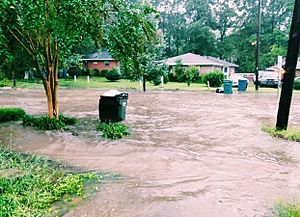
Walltown's Story
How Walltown Started
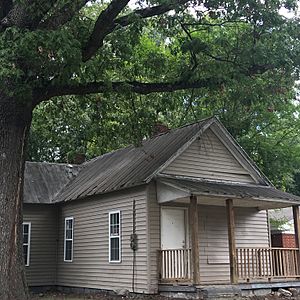
Walltown is named after George Wall. He was a man who was once enslaved. After gaining his freedom, he worked as a custodian at Trinity College. This college later became Duke University. George Wall was born into slavery. He worked on a farm before he became free.
George Wall and his family moved near Trinity College when it came to Durham. He bought a piece of land and built a house there in 1906. More people moved to the area, and it became known as Walltown. It was a place for workers at Duke University and local factories to live. In 1910, the first church was built in the neighborhood. It was named Wall Street Baptist Church, honoring George Wall.
In 1948, two women from Walltown helped people register to vote. They wanted more African-American citizens to vote in a local election. In 1937, the Walltown Community Council was formed. By 1939, women led this group. In 1955, residents gave Frizelle Daye a special award. They called him the "Bronze Mayor." His wife, Callie Daye, was a local beautician. She led the Walltown Housewives League in the 1940s and 1950s. She also wrote a column for The Carolina Times newspaper. Later, she helped lead the NAACP's membership drive in Durham.
In 1958, a big step was taken against school segregation in Durham. Rachel Richardson from Walltown and Evelyn McKissick filed a legal challenge. Many people from Walltown joined protests against segregation.
Walltown School
In 1919, the Walltown Graded School was built. It was a Rosenwald School, which were schools built for African-American children. The school building was made bigger in 1945. In 1955, the old building was taken down and a new one was built.
During the time of desegregation, some African-American students from Walltown went to Brogden Junior High School. White students did not attend Walltown School until 1970. The school later closed. The land was given to the Durham County government in 1994. In 1997, the property was put up for sale. St. James Baptist Church bought the building. They turned it into the St. James Family Life Center. In 2019, Discovery Charter School bought the building. This school focuses on STEM subjects.
Walltown Today
In the 21st century, Walltown has been changing. This change is called gentrification. It happens because Walltown is close to Downtown Durham and Duke University. Walltown was historically a neighborhood for blue-collar workers. Nearby neighborhoods like Watts-Hillandale and Trinity Park have historically been wealthier.
In 2018, leaders from the Walltown Community Association met with city officials. They wanted to find ways to help residents with rising property taxes and rent. These increases were making it hard for some people to stay in their homes.
In October 2000, Joseph and Cynthia Henderson opened the Walltown Children's Theatre. It is a school for dance and performing arts. It is located in a former church building. Durham Parks and Recreation helped fund tuition for students from families with lower incomes.
In 2005, the Walltown Health Clinic opened. It provides healthcare services to the community.
In March 2009, the Walltown Community Recreational Center was built. This city-funded center is next to Walltown Park. It replaced an older center from the time of segregation. A professional basketball team, Bull City Legacy, played their home games here for a time.
Famous People from Walltown
- DJ Nabs, an American DJ and music producer
- Jonathan Wilson-Hartgrove, an American Christian preacher and writer
Important Buildings


